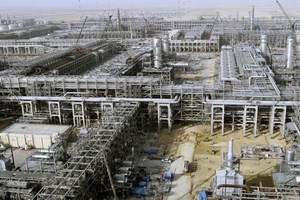Coordinated drone attack cuts Saudi oil production in half
DUBAI (Bloomberg) - Saudi Arabia’s oil production was cut by half after a swarm of explosive drones struck at the heart of the kingdom’s oil industry and set the world’s biggest crude-processing plant ablaze.
Saudi Aramco has had to cut production by as much as 5 MMbpd after the attack on the Abqaiq plant, according to a person familiar with the matter. Iran-backed Houthi rebels in Yemen, who have launched several drone attacks on Saudi targets, claimed responsibility.
The biggest attack on Saudi Arabia’s oil infrastructure since Iraq’s Saddam Hussein fired scud missiles into the kingdom during the first Gulf war, the drone strike highlights the vulnerability of the network of fields, pipeline and ports that supply 10 percent of the world’s crude oil. A prolonged outage at Abqaiq, where crude from several of the country’s largest oil fields is processed before being shipped to export terminals, would jolt global energy markets.
“Abqaiq is the heart of the system and they just had a heart attack,” said Roger Diwan, a veteran OPEC watcher at consultant IHS Markit. “We just don’t know the severity.”
Facilities at Abqaiq and the nearby Khurais oil field were attacked at 4 a.m. local time, state-run Saudi Press Agency reported, citing an unidentified interior ministry spokesman. It didn’t give further details and no further updates have been released.
Aramco believes it will be able to restart production fairly quickly, the person said, asking not to be named before an official announcement. Senior Aramco executives are holding an emergency meeting to assess the situation, another person said.
“For the oil market if not global economy, Abqaiq is the single most valuable piece of real estate in planet earth,” Bob McNally, head of Rapid Energy Group in Washington.
Aramco, which pumped about 9.8 MMbpd in August, will be able to keep customers supplied for several weeks by drawing on a global storage network. The Saudis hold millions of barrels in tanks in the kingdom itself, plus in three strategic locations around the world: Rotterdam in the Netherlands, Okinawa in Japan, and Sidi Kerir on the Mediterranean coast of Egypt.
A satellite picture from a NASA near real-time imaging system published early on Saturday showed a huge smoke plume extending more than 50 miles over Abqaiq. Four additional plumes to the south-west appear close to the Ghawar oilfield, the world’s largest. While that fields wasn’t attacked, its crude is sent to Abqaiq and the smoke could indicate flaring. When a facility stops suddenly, excess oil and natural gas is safely burned in large flaring stacks.
The attacks were carried out with 10 drones and came after intelligence cooperation from people inside Saudi Arabia, rebel-run Saba news agency reported, citing Houthi spokesman Yahya Saree. “Our upcoming operations will expand and would be more painful as long as the Saudi regime continues its aggression and blockade” on Yemen, he said.
Saudi Arabia’s oil fields and pipeline have been the target of attacks over the past year, often using drones mostly claimed by Yemeni rebels. Tensions in the Persian Gulf -- pitting Saudi Arabia and its allies, including the United Arab Emirates, against regional foe and energy giant Iran -- have highlighted the risk to global oil supply.
Today’s attack is the largest and most sophisticated yet. The Houthi forces have used small and medium-sized unmanned aerial vehicles in various roles, according to a United Nations report. Some are loaded with munitions for use as “kamikaze drones” with a range of up to 1,500 kilometers.
Yemen’s Houthi rebels have been battling a Saudi-led coalition since 2015, when mainly Gulf forces intervened to restore the rule of President Abd Rabbuh Mansur Hadi and his government after the Houthis captured the capital, Sana’a. The conflict has killed thousands of people and caused one of the world’s worst humanitarian crises.
The attacks come as Aramco, officially known as Saudi Arabian Oil Co., is speeding up preparations for an initial public offering. The energy giant have selected banks for the share sale and may list as soon as November, people familiar with the matter have said.
Khurais is the location of Saudi Arabia’s second-biggest oil field, with a production capacity of 1.45 MMbpd. Abqaiq contains an oil-processing center, which handles about two-thirds of the country’s production. Abqaiq is home to the world’s largest oil processing facility and crude oil stabilization plant, and it has a crude oil processing capacity of more than 7 million barrels a day, according to the U.S. Energy Information Administration.
Aramco’s media relations department wasn’t immediately available for comment outside of working hours.



